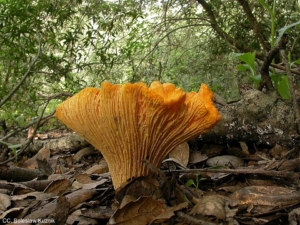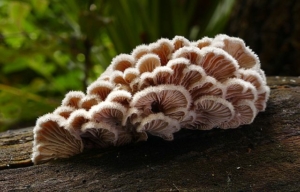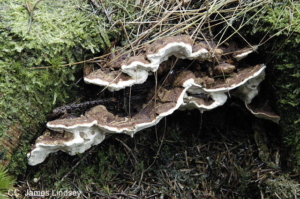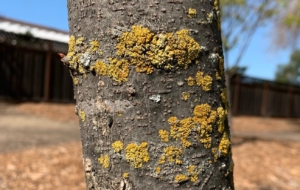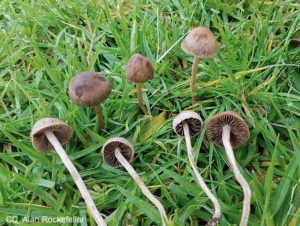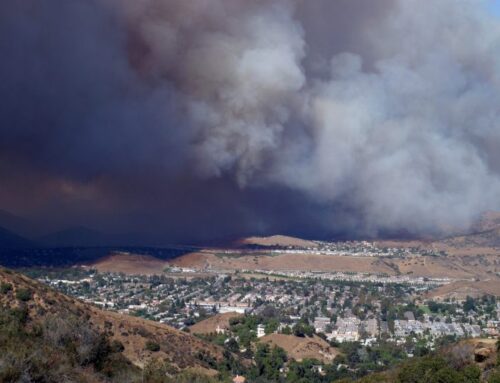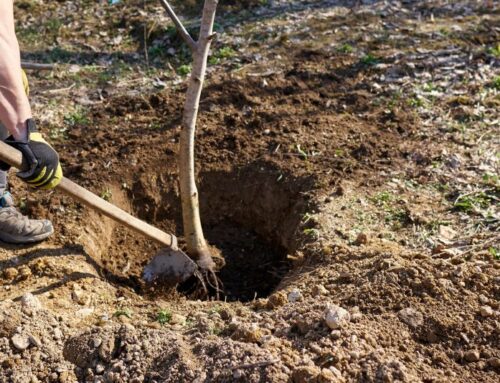Trees interact with numerous species of fungi, some good, some bad, and some merely ugly. The best way to understand the type of interaction is to look at what the fungus eats.
- Good: If it eats dead matter or produces mycorrhizae, it helps the tree obtain nutrients.
- Bad: If it eats the tissues of living trees, it causes decay and usually kills the tree.
- Ugly: If it eats decaying wood or other materials, it's a sign of an unhealthy tree, but is not the primary cause of tree death.
Below is a list of fungi commonly found on and near trees. By observing what they consume, fungi can be categorized into the good, the bad, and the ugly.
The Good
Mycorrhizae
Some fungi form close relationships with tree roots, eating the tree's sugars. Now, this may sound like bad news, but mycorrhizae (pronounced my-kuh-rhy-zee) are actually a mutually beneficial relationship. Mycorrhizae literally mean "fungus roots", and are structures formed by fungi and tree roots. The tree provides sugars for the fungus, and the fungus increases soil nutrient absorption for the tree, a win-win for both parties. Below is a list of fungi that form mycorrhizal associations with trees.
Death Cap (Amanita phalloides)
Death caps are aptly named because consuming them ends in death for humans and other animals. But they're perfectly safe to look at and even touch. Plus, they form mycorrhizae on numerous tree species, especially oaks. So if you see death caps popping up under your trees, don't be alarmed as long as you keep them out of your mouth and your pets.
Oak Chanterelle (Cantharellus californicus)
As their name implies, oak chanterelles form mycorrhizae with many oaks and tanoaks. They are a popular edible mushroom amongst wild mushroom hunters, and can reach over two pounds in weight.
Golden Milkcap
Golden milkcaps form mycorrhizae with many tree species, including oaks, pine, and firs. When crushed or broken, they ooze a milky white latex. Although they're not poisonous, their spicy and acrid flavor renders them unpalatable.
The Bad
Fungi bad for trees are those that colonize tree tissues and digest them, leaving behind a much weaker tree. Some of these fungi feed on inner wood (heartwood), some on outer wood (sapwood), and some are root feeders. Regardless, fungal feeding destroys strong wood and creates spongy or brittle wood. By the time fruiting bodies like mushrooms or conks appear on the tree, fungal decay may have been occurring for years and the tree has a high risk of failure. Once wood decay fungi colonize trees, it's impossible to treat and removal is the safest option. These fungi often invade stressed trees through old wounds and improper pruning cuts, so make sure to take proper care of your trees. Keep an eye out for the list of fungi below.
Artist's Conk (Ganoderma applanatum)
Artist's conk infects trees through existing wounds. Their brown upper surface turns darker when scratched, giving them the name artist's conk. Although fun to draw on, the conk is an indicator of internal decay that can extend for 15 ft vertically into the trunk and roots.
Honey Fungus (Armillaria mellea)
Honey fungus is an edible mushroom that might not be so welcome if it shows up on your tree. They cause root rot and frequently form mushrooms during fall and winter. To check for honey fungus if fruiting bodies are absent, peel back the bark and look for pale, thin fungal roots (aka mycelia).
Western Sulfur Shelf (Laetiporous gilbertsonii)
The Western sulfur shelf is characterized by its orange, yellow, and white stripes, much like candy corn. Young conks are more vivid while older conks start to fade. This is a common culprit of decay in eucalyptus and oak trees.
Oak Bracket (Inonatus dryadus)
Oak bracket fungi are a butt and root rot fungus, meaning they decay the trunk base and roots. The gnarly, bumpy fruiting bodies can be seen on oaks and firs. Infected trees have a high risk of falling over entirely because the whole root system is weakened.
Oyster Mushroom (Pleurotus ostreatus)
Oyster mushrooms get their common name from their looks and flavor, which resemble oysters. Some may rejoice to find them on their plates, but you should be wary if they appear on your tree. Clusters of oyster mushrooms, though tasty to oyster and mushroom devotees, are telltale signs of internal decay, reaching as far as 10 ft from the cluster.
Common Split Gill Fungus (Schizophyllum commune)
Common split gill fungus infects wounded and heat or drought stressed trees. These frilly, pale mushrooms are signs of internal decay.
Western Jack-O-Lantern (Omphalotus olivascens)
Western jack-o-lantern mushrooms are so named for their orange hue and reputed ability to glow in the dark. As cool as they are, spotting these mushrooms on your trees is a sign of decay. But clusters of jack-o-lanterns in a forest grove amongst trees and stumps make for the perfect Halloween setting.
Annosum Root Rot (Heterobasidion annosum)
Annosum root rot is one of the most economically devastating wood-decay fungi. It causes root decay in many tree species, especially conifers. Trees are infected through open wounds and by nearby tree roots of already infected trees.
The Ugly
Some fungi are not parasitic but merely ugly, or perhaps not so ugly, as "beauty is in the eye of the beholder." They can be found on or near trees, but are not directly associated with tree mortality. So get to know the fungi below, and there will be no reason for false alarms!
Lichens
Lichens are an association between fungi and algae, a small photosynthetic organism. The algae provide sugars, and the fungi improve moisture retention. Lichens form reddish, blue-gray, or tan blotches are tree bark and are often associated with older trees in decline. However, lichens merely prefer sunnier branches that are often found on trees with thinning canopies and lichens themselves do not cause tree decline.
Mica Cap (Coprinellus micaceus)
Young mica caps are covered in small, shiny flecks, hence their name. Mushroom clusters are found near tree bases and turn into gooey black piles as they age. As off-putting as this may sound, mica caps are not parasitic and only inhabit trees that have already been weakened by other fungi or diseases.
Lawnmower's Mushroom (Panaeolus foenisecii)
If your tree is surrounded by lawn, chances are you've come across this little brown mushroom. A common North American mushroom, lawnmower's mushrooms pop up all over lawns and often meet their fate when the mower comes. These little guys decompose leaf litter and other dead matter, so are of no concern to your trees.


